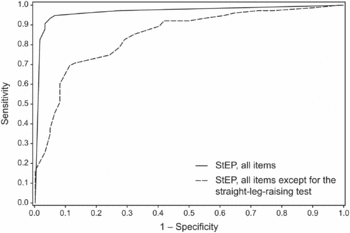Receiver operating characteristic curve: Difference between revisions
imported>Bruce M. Tindall mNo edit summary |
imported>Robert Badgett mNo edit summary |
||
| (2 intermediate revisions by the same user not shown) | |||
| Line 1: | Line 1: | ||
{{subpages}} | {{subpages}} | ||
{{Image|Journal.pmed.1000047.g006.gif|right|350px|ROC curves for the distinction between radicular and axial [[lumbalgia|LBP]] based on StEP. The difference in area under the solid curve compared to the dashed curve is the value of adding the [[straight leg raise]] test to the StEP test.}} | |||
In [[statistics]] and [[diagnostic test]]s, the '''receiver operating characteristic curve''', also called '''ROC curve''', is a "graphic means for assessing the ability of a screening test to discriminate between healthy and diseased persons; may also be used in other studies, e.g., distinguishing stimuli responses as to a faint stimuli or nonstimuli."<ref>{{MeSH}}</ref> | In [[statistics]] and [[diagnostic test]]s, the '''receiver operating characteristic curve''', also called '''ROC curve''', is a "graphic means for assessing the ability of a screening test to discriminate between healthy and diseased persons; may also be used in other studies, e.g., distinguishing stimuli responses as to a faint stimuli or nonstimuli."<ref>{{MeSH}}</ref> | ||
==Area under the ROC curve== | ==Area under the ROC curve== | ||
The area under the ROC curve, called the AUC, c statistic, or c-index may measure discriminatory ability of a test of model. The c-index varies from 0 to 1 and a result of 0.5 indicates that the diagnostic test does not add to guessing.<ref name="pmid7063747">{{cite journal |author=Hanley JA, McNeil BJ |title=The meaning and use of the area under a receiver operating characteristic (ROC) curve |journal=Radiology |volume=143 |issue=1 |pages=29–36 |year=1982 |month=April |pmid=7063747 |doi= |url=http://radiology.rsnajnls.org/cgi/pmidlookup?view=long&pmid=7063747 |issn=}}</ref> Variations have been proposed.<ref name="pmid15900606">{{cite journal |author=Walter SD |title=The partial area under the summary ROC curve |journal=Stat Med |volume=24 |issue=13 |pages=2025–40 |year=2005 |month=July |pmid=15900606 |doi=10.1002/sim.2103 |url=http://dx.doi.org/10.1002/sim.2103 |issn=}}</ref><ref name="pmid18687288">{{cite journal |author=Bangdiwala SI, Haedo AS, Natal ML, Villaveces A |title=The agreement chart as an alternative to the receiver-operating characteristic curve for diagnostic tests |journal=J Clin Epidemiol |volume=61 |issue=9 |pages=866–74 |year=2008 |month=September |pmid=18687288 |doi=10.1016/j.jclinepi.2008.04.002 |url=http://linkinghub.elsevier.com/retrieve/pii/S0895-4356(08)00120-0 |issn=}}</ref> | The area under the ROC curve, called the AUC, AROC, c statistic, or c-index may measure discriminatory ability of a test of model. The c-index varies from 0 to 1 and a result of 0.5 indicates that the diagnostic test does not add to guessing.<ref name="pmid7063747">{{cite journal |author=Hanley JA, McNeil BJ |title=The meaning and use of the area under a receiver operating characteristic (ROC) curve |journal=Radiology |volume=143 |issue=1 |pages=29–36 |year=1982 |month=April |pmid=7063747 |doi= |url=http://radiology.rsnajnls.org/cgi/pmidlookup?view=long&pmid=7063747 |issn=}}</ref> If the diagnostic test gives ratings that are continuous, the AUC is the same as the Wilcoxon test of ranks (also called the [[Mann–Whitney U]] test).<ref name="pmid7063747">{{cite journal| author=Hanley JA, McNeil BJ| title=The meaning and use of the area under a receiver operating characteristic (ROC) curve. | journal=Radiology | year= 1982 | volume= 143 | issue= 1 | pages= 29-36 | pmid=7063747 | ||
| url=http://www.ncbi.nlm.nih.gov/entrez/eutils/elink.fcgi?dbfrom=pubmed&tool=clinical.uthscsa.edu/cite&retmode=ref&cmd=prlinks&id=7063747 }} </ref> Accordingly, the AROC is the probability that the diagnostic test will correctly order the likelihood of disease among two patients randomly selected from a test population. | |||
Variations have been proposed.<ref name="pmid15900606">{{cite journal |author=Walter SD |title=The partial area under the summary ROC curve |journal=Stat Med |volume=24 |issue=13 |pages=2025–40 |year=2005 |month=July |pmid=15900606 |doi=10.1002/sim.2103 |url=http://dx.doi.org/10.1002/sim.2103 |issn=}}</ref><ref name="pmid18687288">{{cite journal |author=Bangdiwala SI, Haedo AS, Natal ML, Villaveces A |title=The agreement chart as an alternative to the receiver-operating characteristic curve for diagnostic tests |journal=J Clin Epidemiol |volume=61 |issue=9 |pages=866–74 |year=2008 |month=September |pmid=18687288 |doi=10.1016/j.jclinepi.2008.04.002 |url=http://linkinghub.elsevier.com/retrieve/pii/S0895-4356(08)00120-0 |issn=}}</ref> | |||
==References== | ==References== | ||
<references/> | <references/> | ||
Latest revision as of 20:27, 20 May 2010

In statistics and diagnostic tests, the receiver operating characteristic curve, also called ROC curve, is a "graphic means for assessing the ability of a screening test to discriminate between healthy and diseased persons; may also be used in other studies, e.g., distinguishing stimuli responses as to a faint stimuli or nonstimuli."[1]
Area under the ROC curve
The area under the ROC curve, called the AUC, AROC, c statistic, or c-index may measure discriminatory ability of a test of model. The c-index varies from 0 to 1 and a result of 0.5 indicates that the diagnostic test does not add to guessing.[2] If the diagnostic test gives ratings that are continuous, the AUC is the same as the Wilcoxon test of ranks (also called the Mann–Whitney U test).[2] Accordingly, the AROC is the probability that the diagnostic test will correctly order the likelihood of disease among two patients randomly selected from a test population.
Variations have been proposed.[3][4]
References
- ↑ Anonymous (2024), Receiver operating characteristic curve (English). Medical Subject Headings. U.S. National Library of Medicine.
- ↑ 2.0 2.1 Hanley JA, McNeil BJ (April 1982). "The meaning and use of the area under a receiver operating characteristic (ROC) curve". Radiology 143 (1): 29–36. PMID 7063747. [e]
Cite error: Invalid
<ref>tag; name "pmid7063747" defined multiple times with different content - ↑ Walter SD (July 2005). "The partial area under the summary ROC curve". Stat Med 24 (13): 2025–40. DOI:10.1002/sim.2103. PMID 15900606. Research Blogging.
- ↑ Bangdiwala SI, Haedo AS, Natal ML, Villaveces A (September 2008). "The agreement chart as an alternative to the receiver-operating characteristic curve for diagnostic tests". J Clin Epidemiol 61 (9): 866–74. DOI:10.1016/j.jclinepi.2008.04.002. PMID 18687288. Research Blogging.